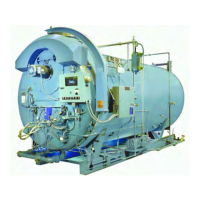Chapter 6 — Adjustment Procedures
6-24 Part No. 750-184
the oil modulating cam to obtain a constant fuel/air ratio through
the entire firing range.
Note: Be sure the to loosen the cam foot locking screws
before adjusting any cam screws or the cam feet may be
damaged.
Since the input of combustion air is ordinarily fixed at any given
point in the modulating cycle, the flue gas reading is determined by
varying the input of fuel at that setting. The adjustment is made to
the metering cam by means of adjusting screws, which are turned
out (counterclockwise from hex-socket end) to increase the flow of
fuel and in (clockwise from hex-socket end) to decrease it. Flow rate
is highest when the cam follower assembly is closest to the
jackshaft.
If oil pressure, primary air pressure, and linkages are properly
adjusted, the metering cam should require minimal adjustment.
Using the flame control switch, position the cam so that the
adjusting screw adjacent to the end, high-fire screw, contacts the
cam follower. Make a combustion analysis at this point.
If an adjustment is necessary, turn the adjustment screw
accordingly to increase or decrease fuel flow. Take a combustion
reading to verify input. Repeat as necessary until the desired flow is
obtained. Continue this pressure, stopping at each adjusting screw,
until the low fire position is reached.
Note: Do not use any lubricant on the adjusting setscrews.
These have a nylon locking insert intended to provide
locking torque and resistance to loosening and a
lubricant could damage the equipment.
Standard Burner Low Fire Adjustment (Heavy Oil)
The fuel input should be adjusted with the low fire cam screw, to
approximately 25% of that at high fire. At low fire the O
2
flue gas
reading should be between 7- 8%.
V. BURNER DRAWER ADJUSTMENT
There are relatively few adjustments that can be made to the
burner; however, a check should be made to assure that all
components are properly located, and that all holding screws are
properly tightened. The diffuser location on gas fired boilers is quite
important. There should be 1/4” distance between the edges of the
diffuser fins and gas outlet tubes (spuds). The setting of an oil fired
burner is less exacting; the diffuser should be located with the skirt
approximately 1-1/8” from the end of the burner tube.
When the proper diffuser location is ascertained, the setting of the
nozzle in relation to the diffuser should be checked. This generally
is set at time of manufacture and seldom needs altering. It is most
important that oil spray does not impinge upon the diffuser. The
distance that the nozzle is behind the diffuser has some latitude,
and individual installations may require a slight deviation. Refer to
Figure 6-10 for initial setup dimensions.

